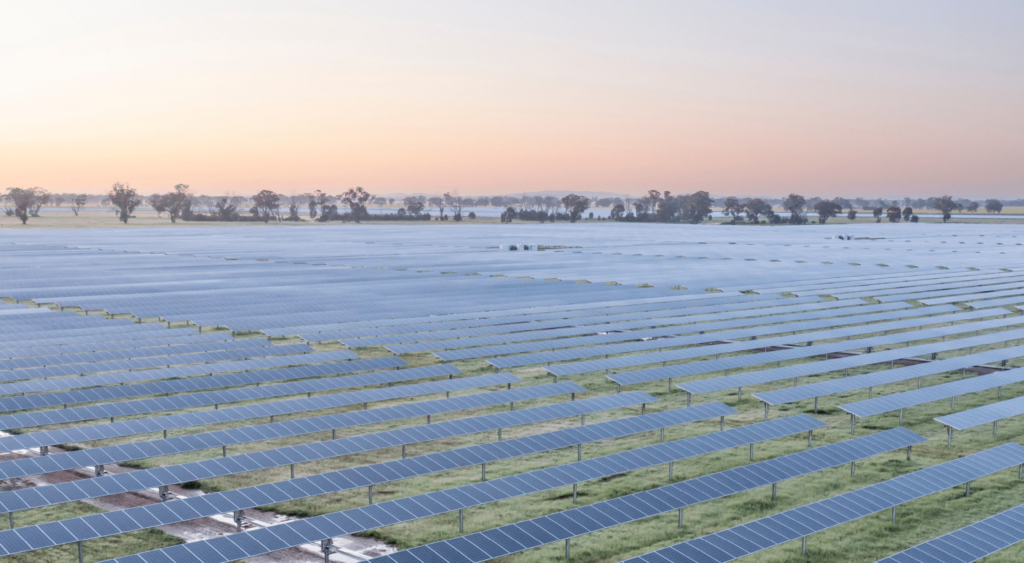ZEN and the Victorian Chambers of Commerce and Industry working together for a net-zero future.
April 5, 2023.
ZEN Energy is proud to be a member of The Victorian Chambers of Commerce and Industry, providing insights on the path of achieving net-zero for Victoria.
This is part of ZEN’s strategy to work with like-minded businesses to accelerate the transition to renewable energy for a positive outcome “…when there’s no longer any coal or gas being used to generate electricity…”, as ZEN CEO Anthony Garnaut mentioned in his interview below. By acting as a community and alongside the government, we will be able to not only achieve Australian mandatory targets, yet increase them such as ramping up the Renewable Energy Target (RET).

Image: Numurkah Solar Farm, in Victoria.
Article from: The Victorian Chambers of Commerce and Industry
ZEN Energy: Committed to renewable solutions
According to ZEN Energy CEO Anthony Garnaut, while Victoria is not the sunniest place in Australia, “it’s a lot sunnier than Germany”, meaning the cost of solar even in Melbourne is a lot cheaper than building a solar farm in the sunniest part of Germany.
“What that means is it’s a pretty good place to set up a business in Victoria if you use a lot of electricity,” he says.
“If you’re a global company, if you’re a data centre thinking, ‘where do I put my next data centre: do I put it in Germany, do I put it in Melbourne?’ If you come to Melbourne, solar is relatively cheap.
“We’ve also got a really good wind resource in Victoria – it’s one of the locations in the world where producing renewable energy is relatively cheap.
“So we think as the renewable transition gathers pace, there will be lots of opportunities for renewable-based manufacturing industries to set up in Victoria to enjoy the excellent wind and relatively excellent sun we have here.”
That’s why ZEN Energy is committed to sustainable energy technologies and fostering zero-carbon communities.
As a renewable retailer, ZEN specialises in providing renewable-based solutions to customers. Understanding that the transition to renewable energy is gradual and requires systemic change, ZEN’s business model involves offering the customer a long-term vision.
“We primarily source our power from solar and wind farms and so our cost base isn’t affected by the ups and downs in the global fossil fuel markets,” Anthony says.
“However, if new solar or wind farms are going to be built, they need to sell that electricity to someone. So ZEN Energy specialises in long-term sustainability partnerships.
“There are 50 electricity retail businesses in the market and most focus on selling one– to three-year contracts. We like to work with partners over the long term, over a five or a 10 or a 15-year time frame.
“What we like to do with customers is sit down, talk through the cost factors that are affecting their business and what they think about sustainability, and then we can design a contract that might involve some combination of direct electricity supply but then maybe also putting solar on roofs or putting in a battery at your business, which might lower the non-electricity costs on your bill.
“We’re set up in such a way that will thrive when there’s no longer any coal or gas being used to generate electricity.”
Anthony is hopeful about the prospects of Victoria’s local renewable market and the economic benefits it may bring.
“The proportion of our electricity that comes from renewable resources is a fair bit higher than most places in the world, even than places like France. Victoria is now getting up there with Germany.
“If we keep going, we’ll get to a zero-carbon electricity grid and before a lot of other places. That opens up a whole new world of industries that will be seeking to exploit the opportunities for low-cost power that comes with these free resources that we have out there in the sun, in the wind that are a lot cheaper to use than the gas and the coal that is now in high demand in the export market.”
However, a successful and sustainable transition will require buy-in and co-operation from individuals, business and government, Anthony says.
“We don’t have a net-zero economy until all of our electricity comes from renewable sources,” Anthony says.
“Households use a little under half of the electricity in Victoria, which means that businesses have more than half a contribution to make to the journey to net zero.
“Until businesses start committing and thinking forward about what that journey is going to look like, the transition to net-zero won’t happen in a stable and predictable way.
“If we can have a coordinated plan, the transition will happen faster, be less bumpy and the destination we get to will be a better destination.
“So I think it’s really important that businesses start thinking about what the next 15 years will look like and getting the conversations going with their families, local governments and through the Victorian Chamber to work out what role they can play as businesses in making this transition as successful as possible.”
Victorian Chamber advocacy
The Victorian Chamber Victorian Chamber of Commerce and Industry has launched a series of advocacy videos endorsing our campaign to support businesses’ transition to a net-zero economy. Achieving a Net-Zero Economy: Roadmap for Victorian Businesses focuses on three core objectives: reducing energy prices, ensuring the reliable supply of energy, and supporting businesses transition to a net-zero economy.
ENDS
